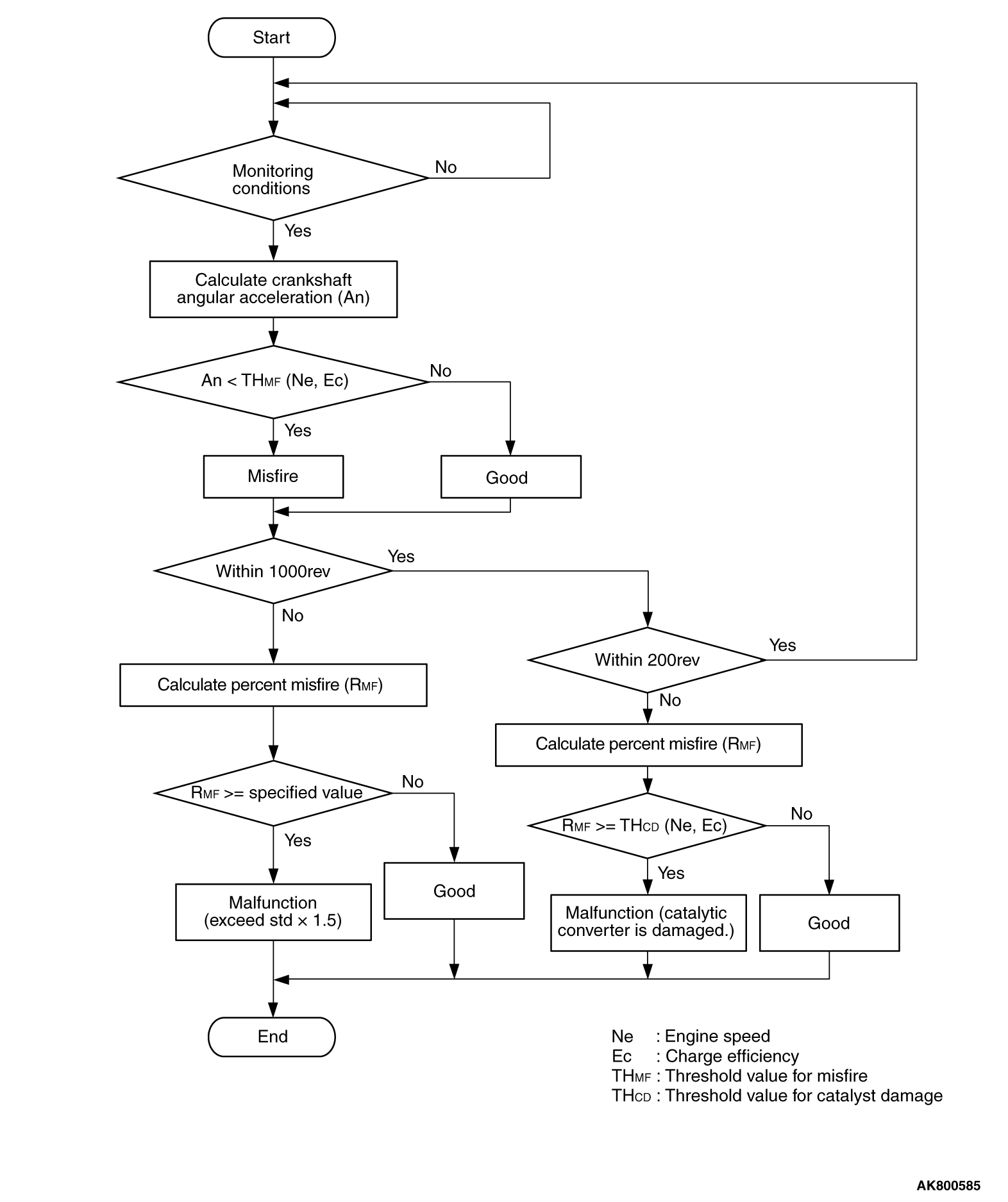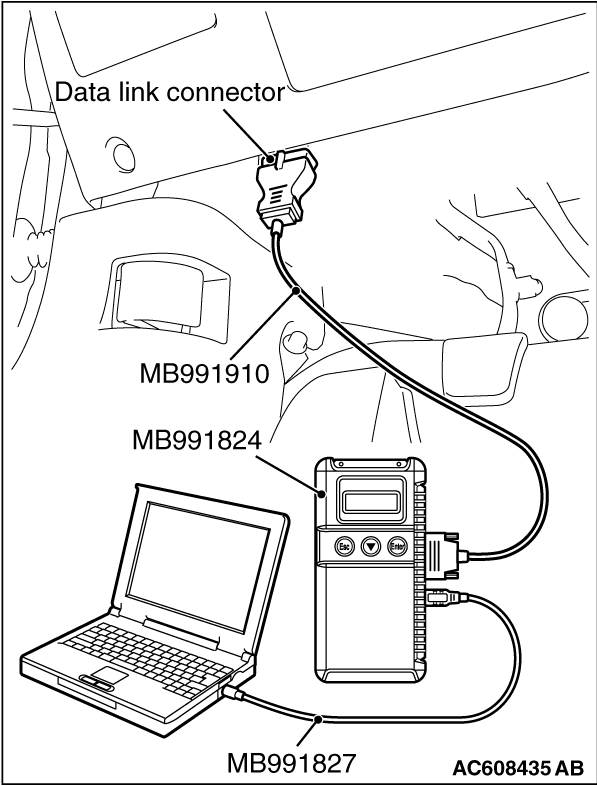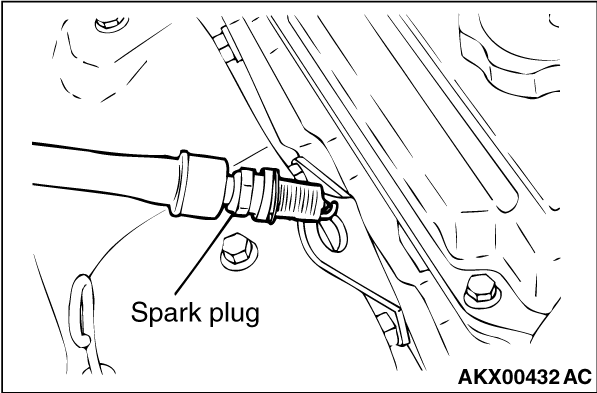![[Previous]](../../../buttons/fprev.png)
![[Next]](../../../buttons/fnext.png)
DTC P0300: Random/Multiple
Cylinder Misfire Detected
TECHNICAL DESCRIPTION
- If a misfire occurs while the engine is running, the engine
speed changes for an instant.
- The ECM checks for such changes in engine speed.
DESCRIPTIONS OF MONITOR METHODS
Monitor angular acceleration of crankshaft and detect
malfunction when negative variation of the angular acceleration is large.
MONITOR EXECUTION
MONITOR EXECUTION CONDITIONS (Other monitor and Sensor)
Other Monitor (There is no temporary DTC stored in memory
for the item monitored below)
Sensor (The sensor below is determined to be normal)
- Camshaft position sensor
- Mass airflow sensor
- Engine coolant temperature sensor
- Intake air temperature sensor
- Barometric pressure sensor
- Throttle position sensor
DTC SET CONDITIONS
Logic Flow Chart

Check Conditions
- Engine speed is between 438 and 6,594 r/min.
- Engine coolant temperature is higher than -10°C (14°F).
- Barometric pressure is higher than 76 kPa (22.4 in.Hg).
- The engine load is with in the positive torque load.
- Adaptive learning is complete for the vane which generates a crankshaft position
signal.
- While the engine is running, excluding rough road driving <M/T> sudden acceleration/deceleration and
fuel shut-off operation.
Judgement Criteria (change in the angular acceleration of
the crankshaft is used for misfire detection)
- Misfire has occurred more frequently than allowed during the last 200 revolutions [when
the catalyst temperature is higher than 1,000°C (1,832°F)].
or
- Misfire has occurred in 1.5 percent <M/T> or 1.8 percent <CVT>
or more of the last 1,000 revolutions (corresponding to 1.5 times the limit of emission standard).
OBD-II DRIVE CYCLE PATTERN
Refer to Diagnostic Function -
OBD-II Drive Cycle -
Pattern
15  .
.
TROUBLESHOOTING HINTS (The most likely causes for this code to be set are:)
- Included air due to lack of fuel.
- Ignition system related part(s) failed.
- Poor crankshaft position sensor.
- Incorrect air/fuel ratio.
- Low compression pressure.
- Skipping of timing belt teeth.
- EGR system and EGR valve failed.
- ECM failed.
|
|
Required Special Tools:
- MB991958: Scan Tool (M.U.T.-III Sub Assembly)
- MB991824: V.C.I.
- MB991827: USB Cable
- MB991910: Main Harness A
|
|
|
STEP 1. Check whether air is included due to the lack of fuel or
not.
|
|
|
- Check whether users have experienced the lack of fuel or not.
|
|
|
Q.
Has the user ever experienced the lack of fuel?
|
|
|
 Erase the diagnosis codes to finish the check. Erase the diagnosis codes to finish the check.
|
|
|
|
|
|
 Go to Step 2. Go to Step 2.
|
|
|
|
|
|
STEP 2. Using scan tool MB991958, check data list item
2: Crankshaft Position Sensor.
|

|
| caution |
To prevent damage to scan tool MB991958, always turn the ignition switch to the "LOCK"
(OFF) position before connecting or disconnecting scan tool MB991958.
|
(1)Connect scan tool MB991958 to the data link connector.
(2)Start the engine and run at idle.
(3)Set scan tool MB991958 to the data reading mode for item 2, Crankshaft Position
Sensor.
- The tachometer and engine speed indicated on the scan tool
should match.
(4)Turn the ignition switch to the "LOCK" (OFF) position.
Q.
Is the sensor operating properly?
 Go to Step 3. Go to Step 3.
 Refer to, DTC P0335 -
Crankshaft Position Sensor Circuit Refer to, DTC P0335 -
Crankshaft Position Sensor Circuit  . .
|
|
|
STEP 3. Using scan tool MB991958, check data list item 26: Long-Term
Fuel Trim.
|

|
(1)Start the engine and run at idle.
(2)Set scan tool MB991958 to the data reading mode for item 26, Long-Term Fuel Trim.
- The fuel trim should be between -12.5 and +12.5 percent
when the engine is 2,500 r/min (during closed loop) after the engine is warmed.
(3)Turn the ignition switch to the "LOCK" (OFF) position.
Q.
Is the specification normal?
 Go to Step 4. Go to Step 4.
 Refer to DTC P0171 -
System too Lean Refer to DTC P0171 -
System too Lean  ,
DTC P0172 -
System too Rich ,
DTC P0172 -
System too Rich  . .
|
|
|
STEP 4. Using scan tool MB991958, check data list item 28: Short-Term
Fuel Trim.
|

|
(1)Start the engine and run at idle.
(2)Set scan tool MB991958 to the data reading mode for item 28, Short-Term Fuel Trim.
- The fuel trim should be between -7.4 and +7.4 percent
when the engine is 2,500 r/min (during closed loop) after the engine is warmed.
(3)Turn the ignition switch to the "LOCK" (OFF) position.
Q.
Is the specification normal?
 Go to Step 5. Go to Step 5.
 Refer to DTC P0171 -
System too Lean Refer to DTC P0171 -
System too Lean  ,
DTC P0172 -
System too Rich ,
DTC P0172 -
System too Rich  . .
|
|
|
STEP 5. Visual check of ignition spark.
|

|
(1)Remove the spark plug and install it to the ignition coil.
(2)Connect the ignition coil connector.
(3)Remove all injector connector.
(4)At the engine start, check each spark plug produces a spark.
Q.
Did it spark?
 Go to Step 7. Go to Step 7.
 Go to Step 6. Go to Step 6.
|
|
|
STEP 6. Check the spark plugs.
|
|
|
Refer to GROUP 16, Ignition System -
On-vehicle Service -
Spark Plug
Check And Cleaning.
|
|
|
Q.
Is the spark plug normal?
|
|
|
 Refer to Symptom Procedures 25 -
Ignition Circuit System Refer to Symptom Procedures 25 -
Ignition Circuit System  . .
|
|
|
|
|
|
 Replace the faulty spark plug. Then go to Step 9. Replace the faulty spark plug. Then go to Step 9.
|
|
|
|
|
|
STEP 7. Check the following items.
|
|
|
(1)Check the following items, and repair or replace the defective component.
- Check for skipped timing belt teeth.
- Check compression.
- EGR valve failed.
|
|
|
Q.
Are there any abnormalities?
|
|
|
 Repair or replace it. Then go to Step 9. Repair or replace it. Then go to Step 9.
|
|
|
|
|
|
 Go to Step 8. Go to Step 8.
|
|
|
|
|
|
STEP 8. Check the trouble symptoms.
|
|
|
(1)Carry out a test drive with the drive cycle pattern. Refer to Diagnostic Function -
OBD-II
Drive Cycle -
Pattern 15  . .
|
|
|
(2)Check the diagnostic trouble code (DTC).
|
|
|
 Replace the ECM. When the ECM is replaced, register the ID code. Refer to GROUP
42B, Diagnosis -
ID Code Registration Judgment Table <Vehicles with KOS> Replace the ECM. When the ECM is replaced, register the ID code. Refer to GROUP
42B, Diagnosis -
ID Code Registration Judgment Table <Vehicles with KOS>  or
GROUP 42C, Diagnosis -
ID Codes Registration Judgment Table <Vehicles with WCM> or
GROUP 42C, Diagnosis -
ID Codes Registration Judgment Table <Vehicles with WCM>  .
Then go to Step 9. .
Then go to Step 9.
|
|
|
|
|
|
 It can be assumed that this malfunction is intermittent. Refer to GROUP 00, How
to Use Troubleshooting/Inspection Service Points -
How to Cope with Intermittent Malfunctions It can be assumed that this malfunction is intermittent. Refer to GROUP 00, How
to Use Troubleshooting/Inspection Service Points -
How to Cope with Intermittent Malfunctions  . .
|
|
|
|
|
|
STEP 9. Test the OBD-II drive cycle.
|
|
|
(1)Carry out a test drive with the drive cycle pattern. Refer to Diagnostic Function -
OBD-II
Drive Cycle -
Pattern 15  . .
|
|
|
(2)Check the diagnostic trouble code (DTC).
|
|
|
 Retry the troubleshooting. Retry the troubleshooting.
|
|
|
|
|
|
 The inspection is complete. The inspection is complete.
|
|
|
|
 .
.![[Previous]](../../../buttons/fprev.png)
![[Next]](../../../buttons/fnext.png)

 .
. Erase the diagnosis codes to finish the check.
Erase the diagnosis codes to finish the check. Go to Step 2.
Go to Step 2.
 Go to Step 4.
Go to Step 4. Refer to DTC P0171 -
System too Lean
Refer to DTC P0171 -
System too Lean  ,
DTC P0172 -
System too Rich
,
DTC P0172 -
System too Rich  .
.
 Go to Step 5.
Go to Step 5. Refer to DTC P0171 -
System too Lean
Refer to DTC P0171 -
System too Lean  ,
DTC P0172 -
System too Rich
,
DTC P0172 -
System too Rich  .
.
 Go to Step 7.
Go to Step 7. Go to Step 6.
Go to Step 6.
 Refer to Symptom Procedures 25 -
Ignition Circuit System
Refer to Symptom Procedures 25 -
Ignition Circuit System  .
. Replace the faulty spark plug. Then go to Step 9.
Replace the faulty spark plug. Then go to Step 9. Repair or replace it. Then go to Step 9.
Repair or replace it. Then go to Step 9. Go to Step 8.
Go to Step 8. .
. Replace the ECM. When the ECM is replaced, register the ID code. Refer to GROUP
42B, Diagnosis -
ID Code Registration Judgment Table <Vehicles with KOS>
Replace the ECM. When the ECM is replaced, register the ID code. Refer to GROUP
42B, Diagnosis -
ID Code Registration Judgment Table <Vehicles with KOS>  or
GROUP 42C, Diagnosis -
ID Codes Registration Judgment Table <Vehicles with WCM>
or
GROUP 42C, Diagnosis -
ID Codes Registration Judgment Table <Vehicles with WCM>  .
Then go to Step 9.
.
Then go to Step 9. It can be assumed that this malfunction is intermittent. Refer to GROUP 00, How
to Use Troubleshooting/Inspection Service Points -
How to Cope with Intermittent Malfunctions
It can be assumed that this malfunction is intermittent. Refer to GROUP 00, How
to Use Troubleshooting/Inspection Service Points -
How to Cope with Intermittent Malfunctions  .
. .
. Retry the troubleshooting.
Retry the troubleshooting. The inspection is complete.
The inspection is complete.